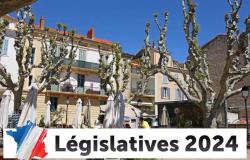C’EastIt is probably the most difficult challenge of the 2024 Summer Olympic Games: meeting the challenge of emitting half as much CO2the main greenhouse gas responsible for climate change, than in London in 2012.
Until now, the Paris 2024 team had only communicated on the distribution of its carbon budget: one third for construction (Olympic and media villages, Saint-Denis aquatic center), one third for transport (athletes, spectators and journalists), and finally one third for the rest (food, energy, etc.).
For the first time, the Organising Committee for the Olympic and Paralympic Games (COJOP) presented its plans for the « contribution » climate. Or how to compensate for 1.473 million tons of CO2or 100,000 tonnes less than the objective displayed by the organisers (1.58 million tonnes). This is both low compared to the total emissions in France each year. But it is also a lot in the perspective of decarbonisation by 2050. In short, behind its technical appearance, this issue is very political: are the Olympic Games compatible with the climate shock?
To answer this, Cojop benefits from the support of Marion Guillou, specialist in food issues and member of the High Council for the Climate, who congratulated it on its “voluntarism” at the opening of the press conference.
Nine international projects
What to learn from these announcements? To date, Paris 2024 has acquired 11.3 million euros of carbon credits. This voluntary compensation system consists of paying financial aid to projects that create or preserve systems that absorb CO2 (reforestation, protection of natural areas, support for renewable energy projects, etc.). In exchange for the money spent, polluting companies obtain the right to deduct the CO from their carbon footprint2 that these actions help to avoid.
The Olympic rings on the Eiffel Tower in Paris. © Photo Olympia de Maismont / AFP
Enlarge image: Illustration 1
In this case, Cojop has decided to support nine international carbon offset projects: in Kenya, the Democratic Republic of Congo, Rwanda, Senegal (where the Youth Olympic Games are to be held in 2026), or still in Vietnam.
Protection of the mangrove, access to water, photovoltaic installation, improved cooking stoves, but also actions in favor of education and against gender inequalities. The projects presented correspond to the criteria of environmental and social responsibility of companies. They were brought to Paris 2024 by a start-up specializing in carbon market consulting, Abatable (which counts among its clients Nestlé, Axa, Chanel, etc.) and the design office EcoAct, a subsidiary of Schneider Electric.
62% of the carbon credits from these international projects have been labelled Verified Carbon Standard (VCS), managed by the American NGO Verra, which alone certifies three quarters of all carbon credits worldwide. (see annexes). It is the most widely used carbon offset standard in the world. Two of the five VCS-labeled projects benefit from an additional label from Verra, which is more focused on biodiversity conservation and community support.
Problem: in May 2021, a joint investigation by Guardian and Unearthed (Greenpeace’s investigative arm) revealed that Verra’s system for calculating emissions reductions for VCS-certified projects was technically unreliable.
Rebelote, in January 2023: The Guardian, British investigative collective SourceMaterial and German weekly The time published a survey showing that 94% of carbon credits certified by Verra from the protection of tropical forests actually had no benefit for the climate. Verra’s certification program is said to have overestimated the threat of deforestation in areas hosting carbon offset projects by an average of 400%, which had the effect of overestimating the beneficial effect of these projects.
Furthermore, carbon offset projects in countries of the South are increasingly controversial for their abuses in terms of respect for human rights, particularly the rights of indigenous peoples, which are increasingly documented in Asia, on the African continent, and in South America.
French carbon offsetting
In addition, Cojop also launched a call for tenders in March 2023 to finance projects in France to offset the emission of 35,000 tonnes of CO equivalent.2.
These projects are stamped “Low-carbon Label”, the the only carbon offset standard applicable in France and which was launched in 2019 by the Ministry of Ecological Transition. “The Low-Carbon Label is a certification framework for changing agricultural or forestry practices synonymous with reducing emissions or carbon capture. It is also now extending to other sectors, such as waste or construction”explains Stéphanie Barral, economic sociologist at the National Institute for Agricultural, Food and Environmental Research (INRAE).
The call for tenders from the organisers of the Olympic Games was structured into three lots, financeable for at least two years: one for “projects developed within the framework of forestry methods”another for agricultural projects and a final one entitled “Other methods”. However, as Cojop confirmed to Mediapart, following budgetary constraints, only the so-called “forestry” lot was ultimately allocated (to the National Forestry Office and the Caisse des Dépôts Forestry Company) and will compensate barely 14,500 tonnes of CO equivalent2.
For the 2024 Olympics, four projects have been selected, in Val-d’Oise, in Aisne and in the Vosges. But the climate effectiveness of this labeling may raise questions because, as Stéphanie Barral points out: “It was the professional organizations that took charge of drawing up the specifications for the “Low Carbon Label”. For its forestry aspect, it was the National Forest Property Center [organisme qui représente les 3,5 millions de propriétaires forestiers privés en France, placé sous la tutelle du ministère de l’agriculture – ndlr] who provided technical expertise. This could give rise to a potential conflict of interest.”
And the researcher added: “The big problem with this label is thatil relies on private, irregular fundingsand that for the moment the credits are unable to with sell. Financing ovens improved for women in sub-Saharan Africa so that they consume less wood remains much cheaper than growing forests in France. » According to the organizers of the 2024 Olympic Games, the cost of carbon offsetting in France would be 6 to 7 times higher than internationally.
We will have to wait until the end of the event to be able to draw up the complete carbon footprint of Paris 2024. The expert think tank The Shifters has just calculated that the impact on the climate of the travel of international spectators could be double that of what is planned so far, around 1.1 million tonnes of CO2.
Concrete with an underestimated carbon footprint
CO emissions2 Olympic constructions could also be underestimated. Firstly because the Arena at Porte de la Chapelle was not counted, because “The city of Paris was going to build it anyway”, with or without Games, explain the organizers.
Then because the Olympic village was partly built with “low-carbon” or even “ultra-low-carbon” concrete. The company delivering the Olympic works is putting forward two solutions “innovative” : the Exegy range from Vinci – which built part of the new district – and the H-UKR concrete from the Hoffmann Green company.
Both products have the same problem: they replace the most polluting component, clinker, with a waste product from steel production, slag. However, this material is notoriously underestimated in industrial carbon footprints.
“At the beginning, the carbon footprint of the milkman was not even countedexplains Guillaume Meunier, expert in low-carbon construction, and co-author of an analysis which has circulated widely among architects, estimating around 400 kilos of CO2 per tonne the carbon footprint of slag. The State has required cement manufacturers to take this into account. But the values chosen are significantly lower than what we had proposed.”
The Ministry of Housing recommended in 2021 to count 83 kilos of CO2 per ton, or 5 times less. “It’s all very well to use low-carbon concrete. But the real solution is to reduce the amount of concrete.”, continues Guillaume Meunier. Despite these enormous resources, the climate voluntarism of Paris 2024 has its limits.






